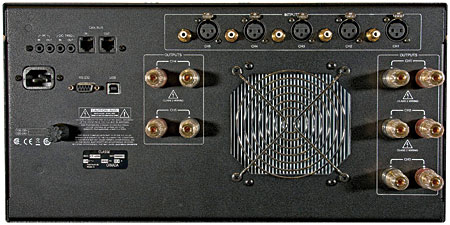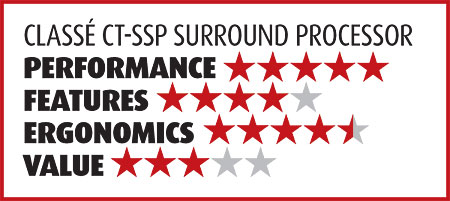Classé CT-SSP Surround Processor and CT-5300 Amplifier Page 3
Naturally, the five-channel CT-5300 amplifier offers reciprocal inputs (although in my setup, I only had enough XLR cabling for the front three channels). Classé’s standard amplifier line currently tops out with the 200-watt-per-five-channel CA-5200, a significant 100 watts less than the rack-version flagship. The CT-5300 isn’t cabinet-friendly at nearly 2 feet deep. And don’t forget the MDF-crushing 113 pounds. Classé informed us at press time that a CA-5300 will be introduced, which will carry the same rated power as the CT-5300 but be housed in chassis that’s the same size as the CA-5200.

The manufacturer’s recommended break-in period for the CT-5300 is an astounding 300 hours, or roughly the life expectancy of a $399 AVR.
Master Sound
One of my favorite CDs for judging audio quality is Sting’s Nothing Like the Sun, mastered by Bob Ludwig. It features one layered cut after another. From the sharp synthesizer fade into the opening classical guitar notes on “Fragile,” the Classé system passed seemingly limitless amounts of information to the Revel Salon2 speakers, where it was instantly spotlighted. The soundstage is at once expansive, broad and organically rich. In simple stereo, the Classé CT-SSP eschews the subwoofer, not that the Revel Salon2 requires any help in the bass. Yet the beauty of Sting’s 150-year-old upright bass comes through with callous buzz and thump. “They Dance Alone” features Eric Clapton, Mark Knopfler, Fareed Haque, and Rubén Blades. Their varying styles are set pretty low in the mix and present a significant challenge to the listener. But on the Classé system, guessing who’s who becomes a winnable game. The soundstage is wonderfully transparent, broad, and deep.

The album that sends shivers down my back, though, is still Pink Floyd’s Wish You Were Here. It will always remind me of October 1987, when I was walking the halls of the Hartford Civic Center looking for something to eat when David Gilmour’s opening guitar riff had me leaving skid marks racing back to my seat. While I didn’t try to crank up the CT-5300 to the levels I experienced that night, there was no doubt that the Classé system was capable of revealing everything in this recording. The terrifying (to me at least) “Welcome to the Machine” has layer upon layer of subterranean bass and synth that would be welcome in any self-respecting Terminator movie. Every time the buzzer sounds, the recording brings you one step closer to something you’d rather not be closer to. If memory serves, the best I ever heard this track sound was a decade ago when I used VTL tube amplification and MartinLogan Request speakers. The Classé/Revel system is as close to that recollection as I’ve come since then. While the former had the expected warmth of tubes and electrostatics, it also resolved the tiniest of details. The Classé combination’s detail resolution was definitely on par. In particular, the synths provided a lush, spine-tingling sensation.
Still, I craved a smidgen more depth from these midsize-sedan-priced electronics, depth that might never be found in late20th-century rock recordings. Perhaps a 19th-century Italian composer brought to life by what is to me the consistently bestrecorded classical label out there, Telarc, would tell a different tale. Louis Lane, conducting the Atlanta Symphony Orchestra in Respighi’s three most famous compositions, did the trick. “Pines Near a Catacomb” is a slow-building, bass-heavy piece that emphasizes the orchestra’s scale, breadth, and depth. Cranked up to much more than lifelike levels (and with my finger on the Mute button in anticipation of any famous Telarc timpani whacks), the orchestra’s power built up seemingly limitlessly. Only cymbal crashes took on a bit of a trash-can aura at such high levels. But this wasn’t at the expense of the rest of the orchestra, which was solidly placed and earthy in presentation. When the piano finally emerges near the restful end of the piece, your mind can almost visually paint the pianist as he delicately presses each key.
Are You Feeling Lucky, Punk?
Lucky Number Slevin is a fun movie with a devilishly good soundtrack that doesn’t rely on a parade of hits to evoke emotion and atmosphere. Low-level bass, palpable silences, odd solo instrumentation like harp and flute, and of course the occasional Bruce Willis monologue contribute to a very creative aural soundscape. I only wish there was more information in the surround channels. By using the remote’s trim function, you can easily make alterations without permanently changing the configuration. Those types of on-the-fly changes only affect the source you’re using and only until you switch sources. If you then bring up the volume level of the surround channels, you might discover that there is in fact a lot of information in those channels, but it’s seriously down in level. This may be what the production crew intended, but
I’m not a purist when it comes to home theater. It’s all about the fun.

I love movies that show snippets in the lives of fictional musicians, like Pure Country from 1992. It’s not a great movie, to be sure, but when George Strait takes the stage, the sound blows you away, even if it is only Dolby Digital 5.1. Now it’s Jeff Bridges’ turn in Crazy Heart, a movie that borders on, well, no it is depressing (and watching him smoke just about made my lungs collapse). But when you finally get some music, it’s all good. The CT-SSP gets some amazing palpability in the bowling-alley concert, where the lead guitarist’s Telecaster is particularly full of bite. The CT-5300 exhibits that jump factor that’s all too hard to come by and makes scenes come alive. In the case of Crazy Heart, it makes you feel like you’re in that bar or that stadium, watching that concert. It’s not just the macrodynamics of a concert setting where the Classé system excels, but the microdynamics exposed in the subtle incidental instrumental music used when Bad travels to his next gig. With the Classé, it’s all very intimate.
I See You
I didn’t get to see Avatar in a cinema when it was released theatrically, but the Classé system certainly gave me a sense of the first-run experience. I was completely entranced for the length (and I do mean length) of the movie, and the DTS-HD Master Audio soundtrack was just as wonderful as the picture. The first helicopter recon mission proved the system’s power and agility. The foreign sounds of Pandora’s jungle and Jake Sully’s breathing, as well as the distant conversation of his group members, were vividly real and resolute. The celestial orchestration in Sully’s first encounter with Neytiri was enough to give me goose bumps. There’s no denying audio’s role in cinema.
There’s also no denying that if you want the very best, you need to seek out the Classé CT-SSP surround processor and CT-5300 amplifier. Classé—definitely not dismissed.






























































